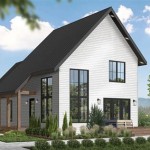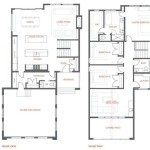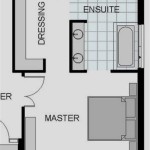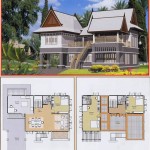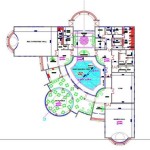Small Open Concept House Plans: Maximizing Space and Light
Open concept house plans have become increasingly popular for their ability to create a sense of spaciousness and flow, even in smaller homes. The removal of walls between key living areas, such as the kitchen, living room, and dining room, allows for better natural light penetration, enhanced social interaction, and increased flexibility in furniture arrangement. This article will delve into the various aspects of small open concept house plans, exploring their benefits, design considerations, and common layout strategies.
The allure of open concept living often stems from a desire to escape the confines of traditional, compartmentalized homes. By eliminating visual barriers, smaller spaces feel larger and more inviting. This is particularly beneficial in urban environments where space is at a premium. Beyond square footage considerations, open concepts promote a more modern and connected lifestyle, fostering interaction between family members and guests as they engage in different activities within the same shared space.
Key Benefits of Small Open Concept House Plans
Open concept design offers several advantages that appeal to homeowners seeking to maximize their living space and enhance their lifestyle. These benefits extend beyond mere aesthetics and contribute to the overall functionality and adaptability of the home.
Enhanced Natural Light and Ventilation: One of the most significant benefits of an open concept layout is the improved distribution of natural light. With fewer walls obstructing the flow of sunlight, natural light can penetrate deeper into the home, reducing the need for artificial lighting during the day. This not only creates a brighter and more cheerful atmosphere but also helps to reduce energy consumption. Moreover, the open flow allows for better natural ventilation, improving air quality and reducing reliance on air conditioning systems. Proper window placement and strategic airflow considerations are crucial for optimizing these benefits within a small space.
Increased Social Interaction and Flexibility: Open concept plans facilitate social interaction by creating a shared space where family members and guests can easily connect and communicate. This is particularly advantageous for families with young children, as it allows parents to supervise activities in different areas of the home while still being present and engaged. The absence of dividing walls also provides greater flexibility in furniture arrangement, allowing homeowners to adapt the space to their changing needs and preferences. Furniture can be easily rearranged to accommodate different activities, such as hosting a dinner party or creating a dedicated play area.
Sense of Spaciousness and Reduced Clutter: Even in a small home, an open concept layout can create a feeling of spaciousness. Removing walls eliminates visual barriers and provides a more expansive view, making the space feel larger than it actually is. This is particularly important in areas with limited square footage. However, it is important to strategically plan storage solutions and design the layout in a way that maintains clarity and order. Open concept living inherently requires careful consideration of clutter management to prevent a feeling of overwhelm. Built-in storage, minimalist design principles, and regular decluttering practices are essential for maintaining a sense of spaciousness and organization in a small open concept home.
Design Considerations for Small Open Concept Spaces
While open concept living offers numerous advantages, it also presents unique design challenges. Successful implementation requires careful planning and attention to detail to ensure that the space is functional, aesthetically pleasing, and meets the needs of the occupants.
Zoning and Definition: The absence of walls in an open concept layout requires alternative methods for defining and separating different functional zones. While the goal is to maintain an open flow, it's essential to visually delineate the kitchen, living room, and dining area to create a sense of order and purpose. This can be achieved through various design strategies, such as using area rugs to define seating areas, varying flooring materials to demarcate different zones, or strategically placing furniture to create visual barriers. Changes in ceiling height or the introduction of architectural elements like columns or beams can also contribute to defining different areas within the open space. Thoughtful zoning helps to prevent the space from feeling like one large, undefined room.
Storage Solutions and Organization: In a small open concept home, storage is paramount. With limited wall space for traditional cabinetry and storage units, it's crucial to incorporate clever and space-saving storage solutions. This might include built-in shelves, hidden storage compartments within furniture, or vertical storage solutions that maximize wall space without encroaching on the living area. Multi-functional furniture, such as ottomans with storage or coffee tables with lift-top mechanisms, can also provide valuable storage options. Furthermore, maintaining a minimalist aesthetic and decluttering regularly are essential for keeping the space organized and preventing visual clutter from overwhelming the open area. Good storage design is paramount for the success of a small open concept house.
Lighting and Acoustics: Lighting and acoustics are critical considerations in open concept design. Since natural light is a primary benefit, maximizing window placement and size is essential. However, it's also important to consider the need for artificial lighting to supplement natural light during the evenings and on overcast days. Layered lighting, incorporating ambient, task, and accent lighting, can create a warm and inviting atmosphere and highlight different areas within the space. Acoustics are equally important, as the open layout can amplify sound and create a noisy environment. Incorporating sound-absorbing materials, such as rugs, curtains, and upholstered furniture, can help to dampen sound and improve acoustics. Strategically placing sound-absorbing panels or using acoustic ceiling tiles can further mitigate noise levels. Careful attention to both lighting and acoustics will contribute to creating a comfortable and functional living space.
Common Layout Strategies for Small Open Concept Homes
Several layout strategies are commonly employed in small open concept house plans to maximize space and create a functional and aesthetically pleasing living environment. These strategies often involve strategic placement of key elements and creative use of space.
The Linear Layout: The linear layout arranges the kitchen, dining area, and living room in a straight line, typically along one wall of the house. This layout is well-suited for narrow spaces and apartments. The kitchen is often placed at one end, followed by the dining area, and then the living room. A peninsula or island can be incorporated into the kitchen design to provide additional counter space and create a visual barrier between the kitchen and the living area. This layout maximizes the use of available floor space and creates a clear and efficient flow between the different zones.
The L-Shaped Layout: The L-shaped layout positions the kitchen and dining area along one wall and the living room along an adjacent wall, forming an "L" shape. This layout is effective for creating a more defined separation between the kitchen and living area while still maintaining an open flow. The corner where the two areas meet can be used as a transition zone or a focal point, such as a breakfast nook or a small seating area. This layout is particularly suitable for homes with a slightly wider floor plan and offers a balance between openness and definition.
The Island-Centric Layout: This layout emphasizes the kitchen island as the central feature of the open concept space. The island serves as a focal point, providing additional counter space, storage, and seating. The dining area and living room are typically arranged around the island, creating a cohesive and interconnected space. This layout is ideal for homeowners who enjoy cooking and entertaining, as it allows them to interact with guests while preparing meals. The island can also serve as a visual barrier, defining the kitchen area while maintaining an open flow to the rest of the living space.
Ultimately, the success of a small open concept house plan relies on careful planning, thoughtful design, and a commitment to maintaining order and organization. By considering the benefits, design considerations, and layout strategies discussed in this article, homeowners can create a beautiful and functional living space that maximizes space and enhances their lifestyle.

10 Small House Plans With Open Floor Blog Homeplans Com

Open Concept Two Bedroom Small House Plan Other Examples At This Link Plans Tiny Floor Sims

10 Small House Plans With Open Floor Blog Homeplans Com

Small Cottage House Plans With Modern Open Layouts Houseplans Blog Com
10 Small House Plans With Open Floor Blog Homeplans Com

Modern Small House Plans And Design Ideas Floor Plan Open Concept Kitchen Living Room Guest One Bedroom

10 Small House Plans With Open Floor Blog Homeplans Com

250 Best Open Concept House Plans Ideas Small Floor

Modern Open Floor House Plans Blog Eplans Com

Small Cabin House Plans With Loft And Porch For Fall Houseplans Blog Com


